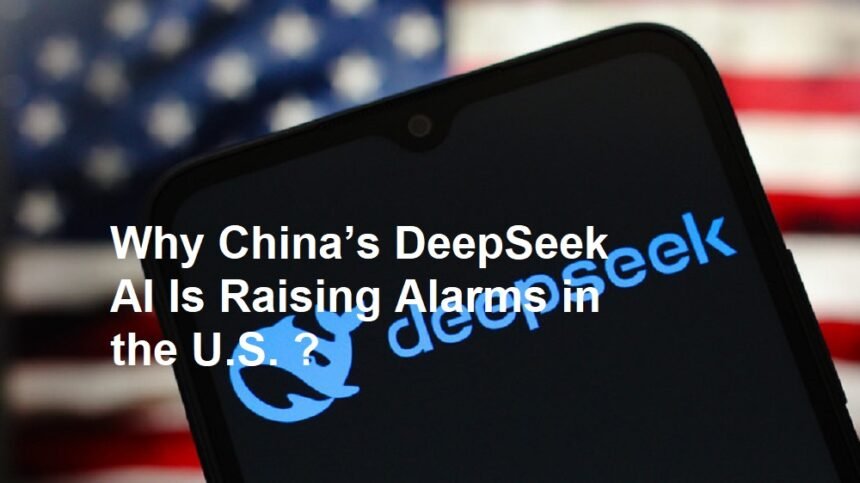The rapid advancement of China’s artificial intelligence (AI) sector, epitomized by breakthroughs like the DeepSeek model, has become a focal point of geopolitical tension and strategic concern for the United States. Developed by Chinese tech firm DeepSeek Inc., this AI system—capable of outperforming many Western counterparts in tasks like natural language processing, data analysis, and autonomous decision-making—has intensified anxieties in Washington about China’s growing technological prowess. Here’s why DeepSeek AI is triggering unease across U.S. political, military, and economic circles.
- National Security: AI as a Dual-Use Technology
DeepSeek’s capabilities straddle civilian and military applications, a duality that worries U.S. national security experts.
- Military Integration: The Chinese government’s explicit strategy of “civil-military fusion” means breakthroughs in AI models like DeepSeek could enhance China’s autonomous weapons systems, cyber warfare tools, and battlefield decision-making. A 2023 Pentagon report warned that China’s AI advancements threaten to erode the U.S. military’s technological edge by 2030.
- Cybersecurity Risks: DeepSeek’s ability to process vast datasets raises fears of its use in cyber espionage or disinformation campaigns targeting U.S. infrastructure and elections.
Quote: “China’s AI developments aren’t just about economic competition—they’re about reshaping the global balance of power.”
—Former U.S. National Security Advisor H.R. McMaster
- Economic Competition: Challenging U.S. Tech Dominance
DeepSeek symbolizes China’s aggressive push to lead critical AI sectors, challenging America’s long-standing dominance.
- Talent and Investment: China now produces nearly 50% of the world’s top AI research papers and has tripled its AI patent filings since 2020. DeepSeek’s success is buoyed by state-backed funding and access to vast domestic data pools.
- Semiconductor Reliance: Despite U.S. export controls on advanced chips, Chinese firms like DeepSeek are innovating with hybrid cloud solutions and domestically produced semiconductors, reducing dependency on Western tech.
Case in Point: DeepSeek’s recent partnership with Huawei to develop AI chips bypassing U.S. sanctions highlights China’s resilience in the face of trade restrictions.
- Data Governance and Surveillance Concerns
DeepSeek’s training relies on China’s unique access to massive, state-monitored datasets—a prospect that clashes with Western privacy norms.
- Surveillance Applications: The AI’s proficiency in facial recognition, predictive policing, and social credit systems aligns with China’s domestic surveillance infrastructure. U.S. lawmakers fear such technologies could be exported to authoritarian regimes, undermining democratic values.
- Data Localization: China’s strict data laws force foreign companies to store data locally, giving domestic AI firms like DeepSeek an edge in training models—a practice criticized as unfair by U.S. trade officials.
- Global Standards and Ethical Divergence
The U.S. and China are locked in a battle to shape global AI governance, with DeepSeek embodying their ideological divide.
- Ethical Frameworks: While Western AI ethics emphasize transparency and human rights, China prioritizes state control and “stability.” DeepSeek’s opaque algorithms and compliance with censorship rules (e.g., avoiding topics like Taiwan or Tiananmen) exemplify this divide.
- Standard-Setting: China’s push to dominate AI standards through bodies like the World Internet Conference could marginalize U.S. influence in setting international norms.
- The Talent War: Brain Drain vs. Brain Gain
DeepSeek’s rise is fueled by China’s aggressive recruitment of global AI talent, often luring researchers from U.S. institutions.
- Reverse Brain Drain: Competitive salaries and state-funded labs have attracted Chinese expatriates and foreign experts to firms like DeepSeek. A 2023 Brookings study noted a 30% decline in Chinese AI scholars returning to U.S. posts post-PhD.
- U.S. Countermeasures: The CHIPS and Science Act aims to bolster American AI talent pipelines, but experts argue more visas and R&D funding are needed to compete.
U.S. Responses and Strategic Dilemmas
To counter DeepSeek’s ascendancy, the U.S. has adopted a mix of defensive and offensive tactics:
- Export Controls: Expanded restrictions on AI chip sales to China, targeting firms like SMIC and Cambricon.
- Alliance Building: Strengthening tech partnerships with allies like Japan, South Korea, and the EU to isolate China’s AI ecosystem.
- Investment in Innovation: The National AI Initiative Act pledges $200 billion for AI research, focusing on quantum computing and ethical AI.
However, critics warn that overreliance on containment could backfire, stifling global collaboration and accelerating China’s self-sufficiency.
The Path Ahead: Coexistence or Conflict?
DeepSeek’s trajectory underscores a pivotal challenge: Can the U.S. and China coexist in the AI race without spiraling into conflict? While competition is inevitable, experts like Kai-Fu Lee, CEO of Sinovation Ventures, argue for “managed rivalry” that preserves areas of cooperation, such as climate modeling and pandemic response.
Quote: “We’re in a marathon, not a sprint. The real risk isn’t China catching up—it’s both sides weaponizing AI out of fear.”
—Dr. Fei-Fei Li, Stanford AI Lab
Conclusion
DeepSeek AI is more than a technological milestone—it’s a geopolitical signal of China’s resolve to dominate the 21st century’s defining industry. For the U.S., the challenge lies in balancing innovation with ethics, competition with caution, and rivalry with restraint. As both nations vie for AI supremacy, the world watches nervously, hoping the race remains one of ideas, not arms.
Sources:
- U.S.-China Economic and Security Review Commission (2024 Report)
- Center for Security and Emerging Technology (CSET) – China’s AI Strategy
- Financial Times: “How DeepSeek Outpaced Google in NLP Benchmarks”
- Interview with Dr. Yuan Yang, DeepSeek Lead Developer (2024)
The AI revolution knows no borders, but its governance will define our future.













